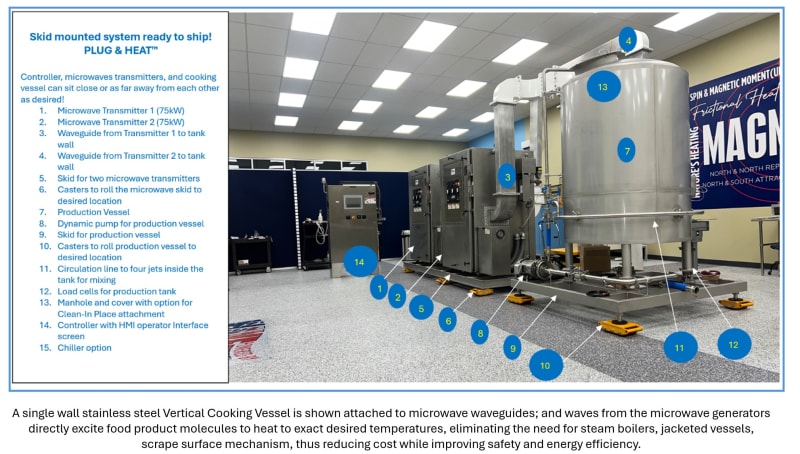Background: Current methods of heating large vessels for cooking or for chemical processes date back to the industrial revolution. Products are heated in large vessels by either open flame or some form of heat applied to the vessel from the bottom. In the 1940’s with the invention of jacketed vessels, heat transfer media including hot water, steam, or high flash point oil was incorporated. Like the internal combustion engine that has fully evolved to be as mature as can be, yet inefficient in converting chemical energy to mechanical energy; the food and process industry has improved on the heat transfer systems and double wall jacketed vessel but in its roots, these methods of heating are efficient and wasteful.
The invention of microwaves in the mid-20th century introduced the first attempt towards the 21st century method of cooking that relies on excitation of product molecules to create friction-generated heating. But, the use of microwaves, induction heating, plasma for property improvements have been on the fringes of applications. Electromagnetic radio frequency waves at different frequencies can be used to directly excite the molecules of products to cause frictional heat.
The two examples below show the difference between what we call direct heating vs. the conventional indirect heating. First, when large chunks of frozen meat is delivered to packaging plants, the frozen meat is placed in a steam room overnight to thaw for efficient hand cutting and packing. This requires the use of some form of fuel or electric heat to boil the water to create the steam for the steam room to temper the meat for packing. Let’s assume propane gas is used to heat water in a boiler to generate the steam; meaning chemical energy of propane is converted to thermal energy to convert water to steam to temper the meat: an indirect use of the original fuel to heat the meat. Whereas a microwave operated tempering oven can apply radio frequency waves at microwave frequencies to excite the molecules of water in the meat to directly thaw the meat. In the second example, we try to heat a cup of milk in a home microwave vs. heating a cup of milk in a pot on a gas stove. The excitation of the milk molecules by electromagnetic waves directly heats the milk not the cup. On the stove, the propane flame heats the bottom of the pot that in turn heats the bottom layers of the milk. The presence of hotspots at the bottom of the pot requires scraping and stirring. This inefficient compared with microwave heated milk where the product is heated not the cup.
Dr. Honary recognized the dangers of cooking and processing products by heat transfer media and after years of research patented a process whereby controlled electromagnetic waves can be applied to large metal cooking vessels to cook foodstuff or process chemicals. His process promises to revolutionize the processing industry and reduce processing energy consumption by as much as 50%.
Like this entry?
-
About the Entrant
- Name:Lou Honary
- Type of entry:individual


